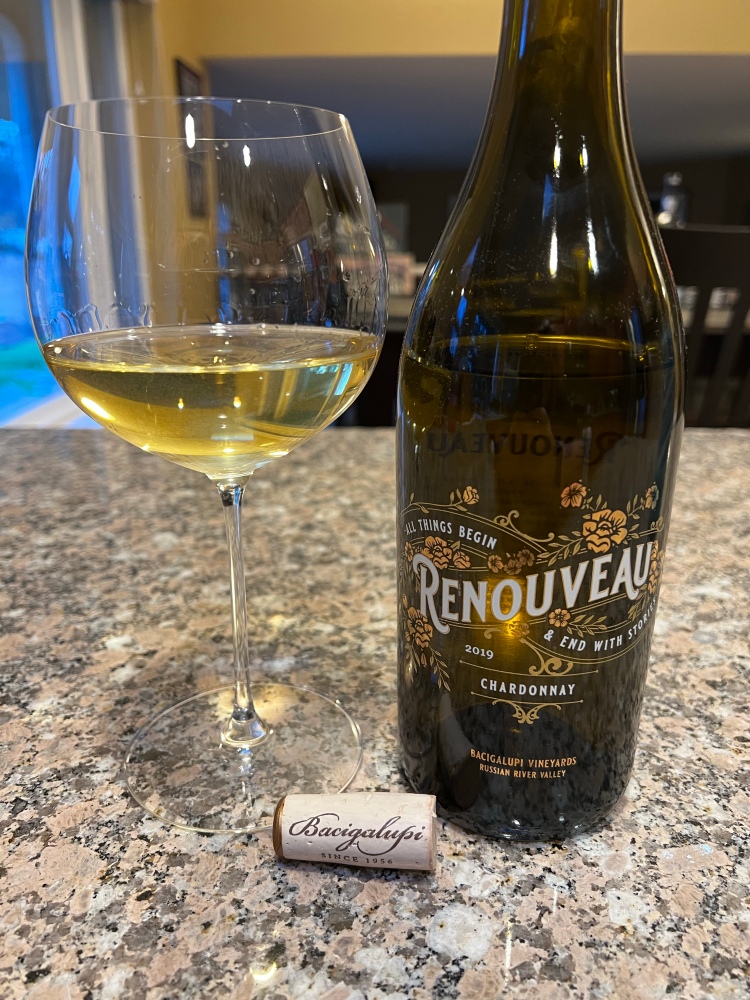
This week, I decided to go with something more familiar. It also happens to be a bottle I’ve been wanting to open since I bought it last year! I’ve written about the Bacigalupi family and vineyards before but I’m going to revisit their story this week. Helen (a pharmacist) and Charles (a dentist) purchased their first plot of vineyard land in the Russian River Valley of Sonoma County in 1956. They started growing their fruit to sell off to wineries and gained a good reputation for the quality of fruit they produced. In 1972, a lawyer named James Barrett decided to purchase a vacant property named Chateau Montelena at the north end of Napa Valley. Since this property had sat vacant for over 20 years, there were no viable grape vines on the property so they had to be replanted. It takes about 3 years for the first crop of mature grapes after planting. While they waited, they wanted to start making wine to earn back some of their investment. They searched out growers and bought fruit. The first white wine produced was in 1972 and made with Riesling grapes from Muir-Hanna vineyard in Napa. In 1973, Mr Barrett, and his esteemed winemaker Mike Grgich, decided to purchase all Chardonnay grapes from a few growers. The breakdown of the final blend was 39% Belle Terre Vineyard, 35% Bacigalupi, 23% Hanna Vineyard, and 3% from Calistoga (up near the Chateau Montelena property).
In 1976, a British wine shop owner named Steven Spurrier, decided to take a trip to Napa, CA. He had heard some good things about the wines coming from this burgeoning region but in Europe, no one was taking them too seriously. Spurrier decided to stage a tasting putting the best French whites and reds up against the best whites and reds he could find in Napa and surrounding areas. On his excursion, he picked up a bottle of this 1973 Chateau Montelena, along with many other wines. He took them back to Paris for what would later be dubbed the ‘Judgment of Paris’. It was a blind tasting with some of the best palates and wine experts the world could offer. When it was all over, that bottle of Chateau Montelena had come out the winner of the whites, and incidentally, the winner of the reds was also from Napa. (It was Cabernet from Stag’s Leap Wine Cellars (not to be confused with Stags’ Leap Winery) SLV vineyard). Also, as a reward, Spurrier was shunned from the French wine world for decades to come.
Following this epic moment in wine history (if you would like to know more, I highly recommend the movie Bottle Shock with Alan Rickman and Chris Pine or reading the book Judgment of Paris), Bacigalupi sold the rights to the vineyard that grew the grapes for this bottle for decades. In 2011, the family decided they wanted to produce their own label using their fruit. They had to wait for the contract on the vineyard to expire, which it finally did and the purchaser opted not to renew. This allowed the family to start producing their own wine with these same vines. In 2018, they harvested their first vintage of Renouveau Chardonnay they would release in 2020. These vines have limited production due to their old age but it should also provide some complexity. While I have a bottle of the 2018, I have two of the 2019, so that is what I will be opening!

Let me start by saying how much I love this bottle! They also include a nice little detail of skipping the standard foil, instead they used a gold tipped cork to match the bottle design. The wine itself was a beautiful deep straw yellow. It was surprisingly fragrant for a Chardonnay, smelling of buttered popcorn, butterscotch, fresh lemon peel, and ripe green apple. I know ABCs (anything but Chardonnay drinkers) commonly dislike the ‘overly buttery’ Chardonnays. The butteriness (a result of a chemical process called malolactic fermentation) is restrained, not like eating a stick of butter or drinking a shot of whipping cream. It does create a luscious feeling of the palate. It also still retained a significant amount of malic acid to help balance the thicker feeling wine. There was a substantial warming effect once ingesting, indicating it’s higher alcohol content. I paired it with some beef tamales I had in the freezer. I love corn and oaked chardonnay, especially if it has a note of butter. The tamales were perfect. The addition of sour cream and guacamole were heavy enough to balance the heaviness of the wine. The buttery popcorn flavors in the wine were perfect for the masa in the tamales. The toasted hints from the oak the wine was aged in simulate the flavor of roasted corn. All of it was lovely and improved by the length of time it lingered on the back of the palate. One thing about Chardonnay, some styles are better as food wines and not intended to slowly sip on a nice afternoon. This bottle would be fantastic with a crab and corn chowder also, but I’d try it with nachos also!